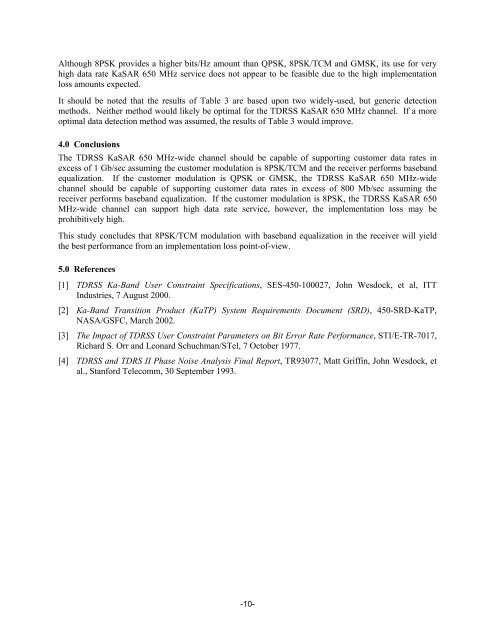AN ASSESSMENT OF THE BIT-ERROR-RATE ... - SpaceOps
AN ASSESSMENT OF THE BIT-ERROR-RATE ... - SpaceOps
AN ASSESSMENT OF THE BIT-ERROR-RATE ... - SpaceOps
Create successful ePaper yourself
Turn your PDF publications into a flip-book with our unique Google optimized e-Paper software.
Although 8PSK provides a higher bits/Hz amount than QPSK, 8PSK/TCM and GMSK, its use for very<br />
high data rate KaSAR 650 MHz service does not appear to be feasible due to the high implementation<br />
loss amounts expected.<br />
It should be noted that the results of Table 3 are based upon two widely-used, but generic detection<br />
methods. Neither method would likely be optimal for the TDRSS KaSAR 650 MHz channel. If a more<br />
optimal data detection method was assumed, the results of Table 3 would improve.<br />
4.0 Conclusions<br />
The TDRSS KaSAR 650 MHz-wide channel should be capable of supporting customer data rates in<br />
excess of 1 Gb/sec assuming the customer modulation is 8PSK/TCM and the receiver performs baseband<br />
equalization. If the customer modulation is QPSK or GMSK, the TDRSS KaSAR 650 MHz-wide<br />
channel should be capable of supporting customer data rates in excess of 800 Mb/sec assuming the<br />
receiver performs baseband equalization. If the customer modulation is 8PSK, the TDRSS KaSAR 650<br />
MHz-wide channel can support high data rate service, however, the implementation loss may be<br />
prohibitively high.<br />
This study concludes that 8PSK/TCM modulation with baseband equalization in the receiver will yield<br />
the best performance from an implementation loss point-of-view.<br />
5.0 References<br />
[1] TDRSS Ka-Band User Constraint Specifications, SES-450-100027, John Wesdock, et al, ITT<br />
Industries, 7 August 2000.<br />
[2] Ka-Band Transition Product (KaTP) System Requirements Document (SRD), 450-SRD-KaTP,<br />
NASA/GSFC, March 2002.<br />
[3] The Impact of TDRSS User Constraint Parameters on Bit Error Rate Performance, STI/E-TR-7017,<br />
Richard S. Orr and Leonard Schuchman/STel, 7 October 1977.<br />
[4] TDRSS and TDRS II Phase Noise Analysis Final Report, TR93077, Matt Griffin, John Wesdock, et<br />
al., Stanford Telecomm, 30 September 1993.<br />
-10-


